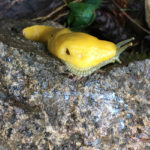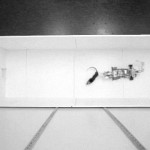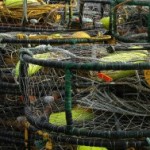Oh Frabjous Day! Time to slay some jabber-demons and admit it:
I have, on occasion, been known to take photos in mirrors and through microscope lenses…and telescopes. And binoculars.
…and it’s totally possible that at least one of my dissertation defense slides originated this way.
But let’s get some methodology straight: “this way” doesn’t mean I use high-tech camera-gadgets attached to fancy optical-gizmos – I stick my digital camera right up to whatever eyepiece is staring me in the…eye…and snap away. An act of desperation? Perhaps.
Since I’ve been lucky enough to wonder through science wander-land, I will share some of my adventures with you:
These are human chromosomes. We normally have 46 of them, organized into 23 pairs. Different organisms have different numbers: woolly mammoths had 58 chromosomes, for example, and kangaroos have 12.
The chromosome spread on the left is from an amniocentesis sample, shot through a microscope during my former day job as a cytogenetic technician.
California quail — Callipepla californica — the state’s official bird.
Fun quail fact: the birds are highly social, and one of their daily activities is a communal dust bath. Sign me up!
Shot through a pair of ancient binocs.
Zebrafish embryos, approximately three days old. They’re still carting around yolk sacs — they’ll ditch those prior to adulthood.
Once upon a time, I worked for a bit in a zebrafish lab and studied olfactory learning. Yes, fish can smell.
Shot through a kick-ass microscope.
This is a cockroach.
Under a microscope.
I love bugs.
A bald eagle — Haliaeetus leucocephalus — or as I’ve heard it pronounced, a bald “agle” — rhymes with bagel. The United States national bird.
Fun agle facts: diving speeds can reach 90 mph, wing spans 6-8 ft. Females are larger than males.
Not fun fact: in the 1950s, there were only 412 nesting pairs in the lower 48 states.
Shot through a sweet birding scope on Maryland’s Eastern Shore.
Dividing HeLa cells. Very interesting history.
The cells are in the last stage of cell division, called cytokinesis, where the two daughter cells are separating.
Shot toward the end of grad school when I needed a distraction. It’s like watching cells divide…
[Tumtum tree haiku —
Strange lumpy thing by my house.
No clue what it is.]
I thought the binocs + camera would answer my question. Alas.
Any thoughts?
Slugnads, the jabber-slayer.
Commence futterwacken.
Callooh! Callay!















The time has come to talk of many things,
“Of shoes–and ships–and sealing-wax–
Of cabbages–and kings–
And why the sea is boiling hot–
And whether pigs have wings.”
From The Walrus and the Carpenter
I love Alice (in Wonderland and Through the Looking Glass), thought I’d chip in with a bit from another Lewis Carroll poem.
Great idea to take pictures through scope lenses, I never really thought about it, or realized the results would look so good.
Yes!!
Maybe I should have borrowed from the mock turtle for our scicom philosophy:
“What is the use of repeating all that stuff, if you don’t explain it as you go on? It’s by far the most confusing thing I ever heard!”
I often feel like science is this crazy wonderland — exotic, elegant, beautiful, bizarre — truly ‘curioser and curiouser’ and very much like the worlds of carroll’s imagination.
Thanks :-) I’m a supporter of rudimentary techniques.
I second Sandeep. Amazing photos considering the technique. Seems like the microscope companies just want to sell the fanciest technology to scientists when something simple will do just as well. Thanks for sharing!
Thanks, Melissae! Cheers!